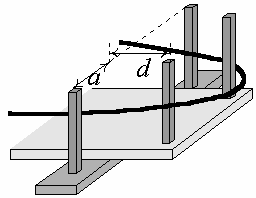|





| |
4-Point Bend Tester
For Fiber and Tape Strength Measurement
Purpose
 The 4-point bend tester is a modification
[refs. 1,
2] of the well known test that is specifically
designed for making measurements on relatively weak or compliant fibers
and tapes; it compliments our 2point bend apparatus for higher
strength specimens. The test specimen is held in a "single ended" mount
that makes immersion in
a test environment especially simple. The failure stress is calculated
from
the displacement of the loading pins at failure, rather than the load,
enabling
strength measurement of very thin, compliant specimens. While the
apparatus
is designed for strength measurement of weak optical fibers, it may
also
be used for making measurements of other physical variables as a
function
of bending strain. Much of the hardware is common to our 2-point bend
apparatus;
purchasing the 4-point bend system as an upgrade to that system
represents
a substantial cost saving. The 4-point bend tester is a modification
[refs. 1,
2] of the well known test that is specifically
designed for making measurements on relatively weak or compliant fibers
and tapes; it compliments our 2point bend apparatus for higher
strength specimens. The test specimen is held in a "single ended" mount
that makes immersion in
a test environment especially simple. The failure stress is calculated
from
the displacement of the loading pins at failure, rather than the load,
enabling
strength measurement of very thin, compliant specimens. While the
apparatus
is designed for strength measurement of weak optical fibers, it may
also
be used for making measurements of other physical variables as a
function
of bending strain. Much of the hardware is common to our 2-point bend
apparatus;
purchasing the 4-point bend system as an upgrade to that system
represents
a substantial cost saving.
Description
The bend apparatus, shown schematically above, consists of four pins
through which the fiber or tape is threaded. The specimen is held
loosely in position by collars (not shown). The center two pins are
moved by a stepper motor
to apply the strain. The apparatus consists of:
 |
stepper motor controlled translation stage and controller with
digital position readout in m. |
 |
bending hardware for mounting on the translation stage. |
 |
additional bending hardware for the 3-point bend configuration. |
 |
acoustic break detector plus acoustic transducer. |
 |
digital interface designed for connection to the parallel
printer port of an IBM PC or compatible. Does not require an expansion
slot if an existing printer port is used. |
 |
software for complete control of the system from an IBM PC or
compatible. |
 |
miscellaneous software utilities for statistical analysis of
results and data presentation. |
The software is extremely powerful featuring:
 |
strength measurement under conditions of constant stress or
strain rate. |
 |
reports failure stress and strain, pin speed, strain rate,
stress rate and time to failure and all other key experimental
parameters. |
 |
data logging mode is available where measurements of
experimental parameters can be made as a function of applied strain. |
 |
result reporting format is fully configurable; results are sent
to the computer screen, a file and optionally to a printer. |
 |
able to shell to DOS before or after a test to execute a user
specified command. |
 |
full color, simple to use menu driven user interface. |
 |
fully configurable by the user both from profile files and,
on-the-fly, by menus. Configurable parameters include fiber dimensions
and elastic properties, face plate gap for loading fiber, speed
parameters, screen menu colors, etc.. |
Specimen Dimensions
The apparatus and specimen dimensions must be carefully chosen to avoid
exceeding the operating parameters of the apparatus. Weak or thick
specimens
will fail at a small pin deflection leading to low precision. Strong or
thin
specimens will be pushed through the pins without failure (our 2-point
bend
apparatus should then be used). The apparatus is supplied with two
different
pin spacings, a, of 9.5 or 19 mm and can also be used in a
3-point
bend configuration. While this provides considerable flexibility, other
pin
spacings might be required to successfully test any given fiber
diameter/strength
combination. Please
to
discuss your specific application.
Fracture Detection
While the system includes acoustic fracture detection circuitry, very
weak specimens tested in 4-point bending might not generate a
sufficiently strong acoustic signal. The apparatus can be stopped
manually when the break is
observed. Alternatively, optical or strain gauge fracture detection
circuits
could be connected to the acoustic trigger circuitry.
Options
-
If you already have a
Fiber Sigma Two-Point Bend Tester based on the Aerotech or ALM translation
stage, the additional
components required for the four-point bend system can be obtained
without
having to purchase a second translation stage and related electronics
(4PU-2).
- Mounting Kit
-
A mounting kit (MOUNT) includes 12"x12"
base plate, support rod, 2 brackets and a laboratory jack. The kit can
support the bend apparatus at 45º or 90º (or at any other
angle) and facilitates immersing the faceplates in liquid test
environments.
Requirements
The system comes complete except that an PC with a parallel
printer port is required. A minimum of an Intel 80386 machine is recommended.
The control software is DOS based but a Windows version is
in development.
Ordering Information
|
Description |
Part# |
|
Complete 4-point bend system
(including all hardware, electronics, software and cables) |
4P-2 |
|
4-point bend upgrade for two-point
system
(TP-2) (includes mechanical fixtures and software) |
4PU-2 |
|
Mounting kit |
MOUNT |

References
-
G. J. Nelson, M. J. Matthewson and B. Lin,
"A novel four-point bend test for strength measurement of optical
fibers and thin
beams - part I: bending analysis", J. Lightwave Tech. 14
555-563, 1996.
-
M. J. Matthewson and G. J. Nelson, "A novel
four-point bend test for strength measurement of optical fibers and
thin beams - part II: statistical analysis", J. Lightwave Tech.,
14 564-571,
1996.
|

